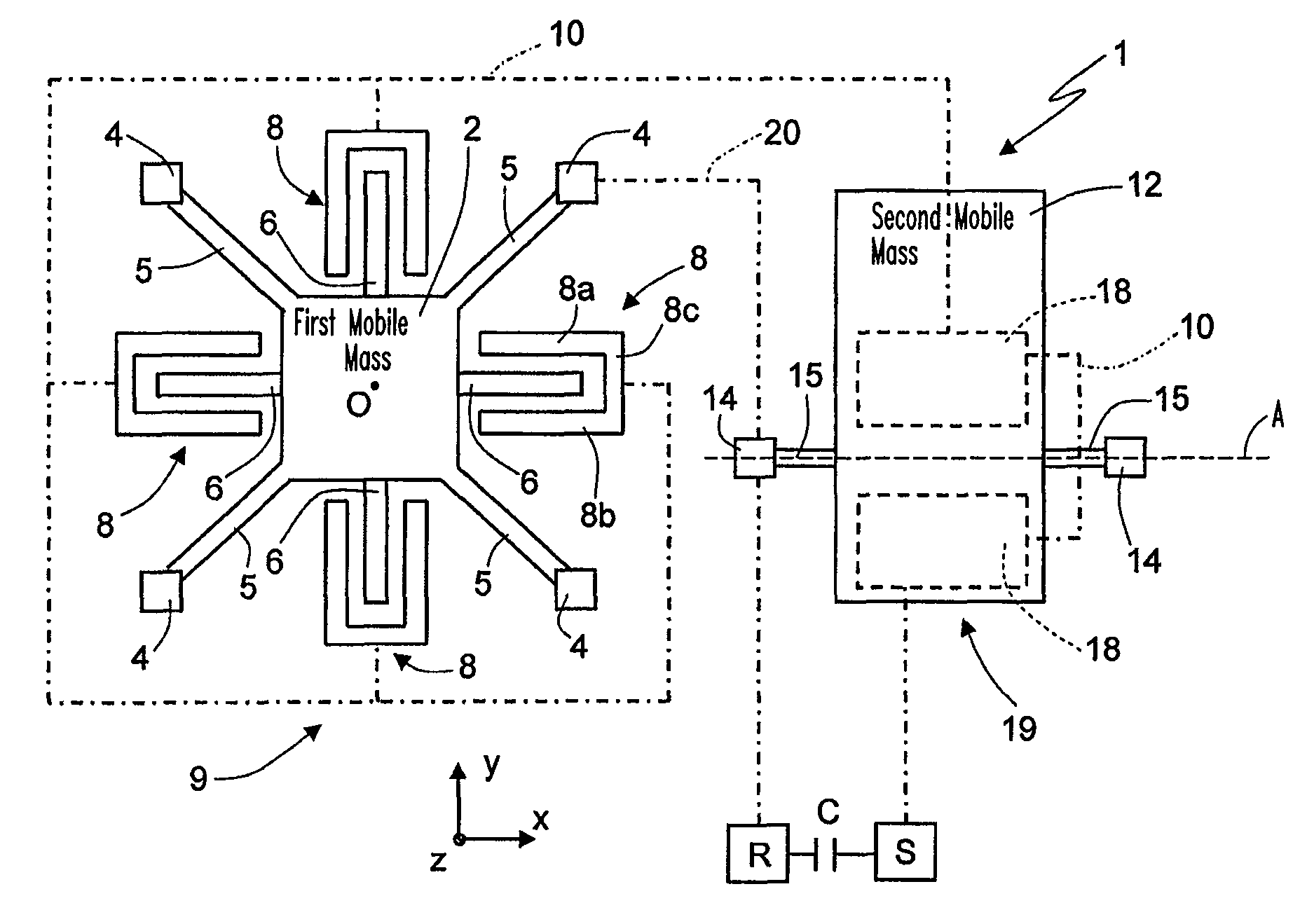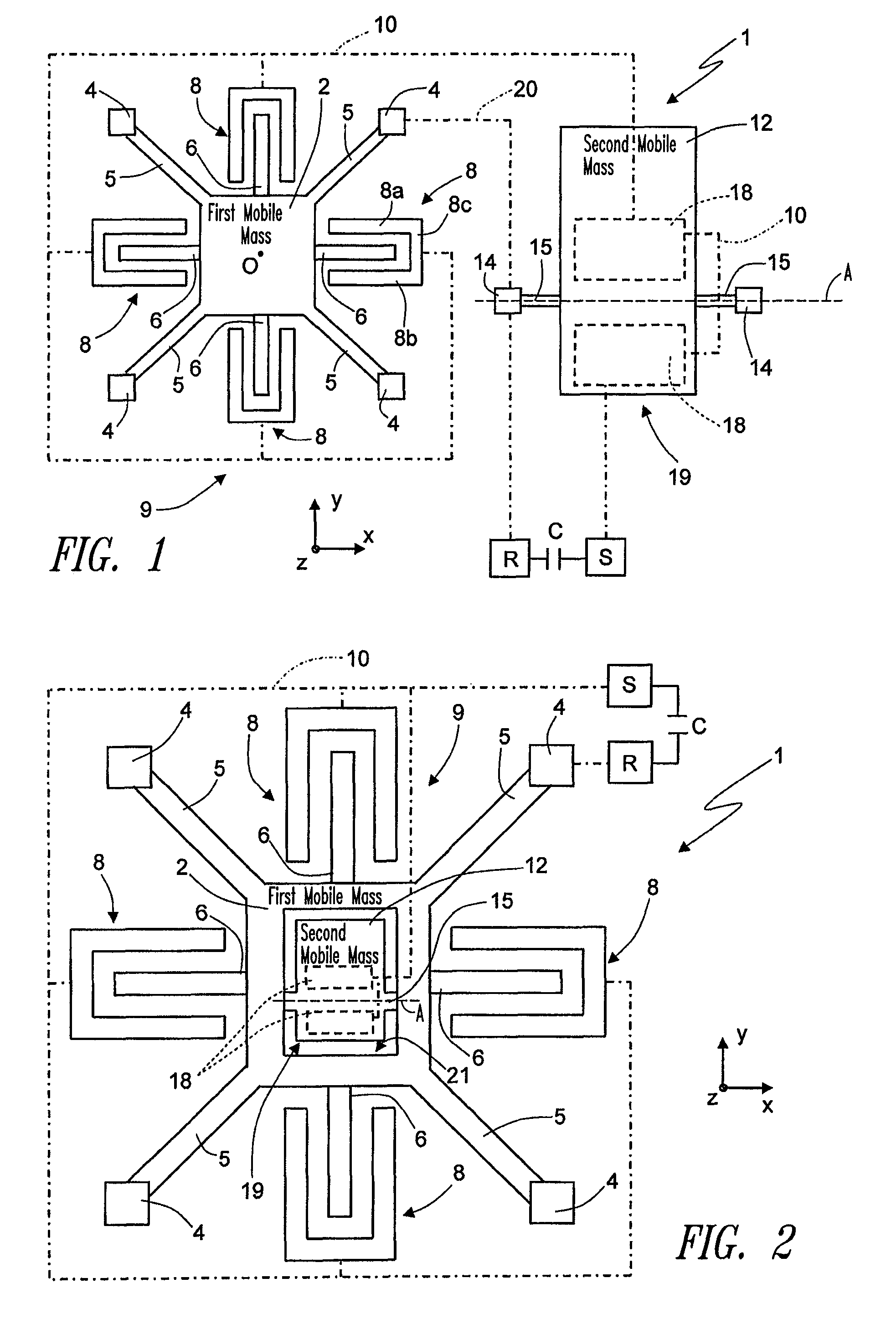Microelectromechanical inertial sensor, in particular for free-fall detection applications
a micro-electromechanical and sensor technology, applied in the direction of acceleration measurement in multiple dimensions, acceleration measurement using interia forces, mechanical means for characerising devices, etc., can solve the problems of permanent damage and consequent loss of stored data, portable apparatuses are very liable to violent impact, and hard disks may suffer damage when used in portable applications
- Summary
- Abstract
- Description
- Claims
- Application Information
AI Technical Summary
Benefits of technology
Problems solved by technology
Method used
Image
Examples
second embodiment
[0033]FIG. 2 shows the inertial sensor 1, which is advantageous in that it enables a reduction of a corresponding area occupation.
[0034]In detail, unlike what has been described previously, the first mobile mass 2 is hollow, frame shaped, and defines inside it a window 21. The second mobile mass 12 is housed inside the window 21, and the second elastic elements 15 are fixed to internal sides of the frame (in this case the second anchorages 14, as likewise the second electrical interconnections 20, are not present). The remaining part of the detection structure is not modified, and in particular the configuration and arrangement of the mobile electrodes 6 and of the first and second fixed electrodes 8, 18, as likewise their interconnections, which enable automatic detection of the vector sum of the components of acceleration ax, ay and az, is not changed.
third embodiment
[0035]the inertial sensor 1 envisages a different configuration of the first detection structure 9 sensitive to accelerations in the plane xy, in particular substantially similar to what is described in US Publication No. 2005 / 0274184 A1 filed on Sep. 23, 2004 in the name of the present applicant, relating to a planar inertial sensor.
[0036]In detail (FIG. 3), the first mobile mass 2 has in plan view a circular shape and is connected to the substrate by means of just one first anchorage 4, set centrally. The first mobile mass 2 has a central hole 22 delimiting an internal circumference thereof. The first anchorage 4 extends inside the central hole 22 and is connected to the internal circumference by the first elastic elements 5, which have in this case the shape of an isotropic spiral, having a reduced width so as to enable displacements of the first mobile mass 2 in any planar direction. The mobile electrodes 6 are formed by a plurality of rings 24, concentric with respect to one an...
first embodiment
[0037]The second detection structure 19 is not modified with respect to the In particular, the first electrical interconnections 10 connect the various arched portions 26 to one another (in a way not illustrated) and to the second fixed electrodes 18, while the second electrical interconnections 20 connect the first and second anchorages 4, 14.
[0038]As described in detail in the aforesaid document, the first mobile mass 2 is sensitive to accelerations acting along any direction of the plane xy, and, as it moves in this direction, the distance of separation between the rings 24 and the arched portions 26 varies. The capacitive variation is also in this case increasing and directly proportional to the acceleration acting on the inertial sensor in any direction lying in the plane xy (in this case, consequently, only one capacitor for detection of accelerations in the plane xy is present, in so far as the sensor does not detect in this case the components of acceleration, but directly ...
PUM
 Login to View More
Login to View More Abstract
Description
Claims
Application Information
 Login to View More
Login to View More - R&D
- Intellectual Property
- Life Sciences
- Materials
- Tech Scout
- Unparalleled Data Quality
- Higher Quality Content
- 60% Fewer Hallucinations
Browse by: Latest US Patents, China's latest patents, Technical Efficacy Thesaurus, Application Domain, Technology Topic, Popular Technical Reports.
© 2025 PatSnap. All rights reserved.Legal|Privacy policy|Modern Slavery Act Transparency Statement|Sitemap|About US| Contact US: help@patsnap.com



